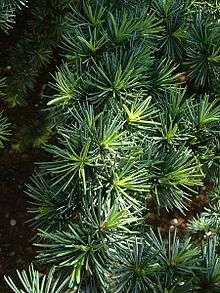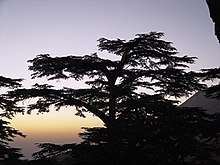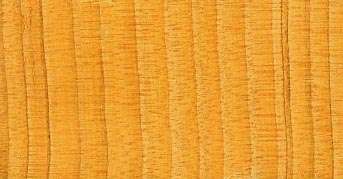Cedrus
Cedrus, common English name cedar, is a genus of coniferous trees in the plant family Pinaceae (subfamily Abietoideae). They are native to the mountains of the western Himalayas and the Mediterranean region, occurring at altitudes of 1,500–3,200 m in the Himalayas and 1,000–2,200 m in the Mediterranean.[1]
| Cedar | |
|---|---|
| Lebanon cedar in Al Shouf Cedar Nature Reserve, Barouk, Lebanon | |
| Scientific classification | |
| Kingdom: | Plantae |
| Clade: | Tracheophytes |
| Division: | Pinophyta |
| Class: | Pinopsida |
| Order: | Pinales |
| Family: | Pinaceae |
| Subfamily: | Abietoideae |
| Genus: | Cedrus Trew |
| Species | |
|
See text | |
Description

Cedrus trees can grow up to 30–40 m (occasionally 60 m) tall with spicy-resinous scented wood, thick ridged or square-cracked bark, and broad, level branches. The shoots are dimorphic, with long shoots, which form the framework of the branches, and short shoots, which carry most of the leaves. The leaves are evergreen and needle-like, 8–60 mm long, arranged in an open spiral phyllotaxis on long shoots, and in dense spiral clusters of 15–45 together on short shoots; they vary from bright grass-green to dark green to strongly glaucous pale blue-green, depending on the thickness of the white wax layer which protects the leaves from desiccation. The seed cones are barrel-shaped, 6–12 cm long and 3–8 cm broad, green maturing grey-brown, and, as in Abies, disintegrate at maturity to release the winged seeds. The seeds are 10–15 mm long, with a 20–30 mm wing; as in Abies, the seeds have two or three resin blisters, containing an unpleasant-tasting resin, thought to be a defence against squirrel predation. Cone maturation takes one year, with pollination in autumn and the seeds maturing the same time a year later. The pollen cones are slender ovoid, 3–8 cm long, produced in late summer, and shedding pollen in autumn.[1][2]
Taxonomy
Cedars share a very similar cone structure with the firs (Abies) and were traditionally thought to be most closely related to them, but molecular evidence supports a basal position in the family.[3][4]
Taxa


The five taxa of Cedrus are assigned according to taxonomic opinion to between one and four species:[1][5][6][7][8][9][10][11][12][13][14]
| Image | Name | Common name | Synonyms | Distribution | Description | Varieties |
|---|---|---|---|---|---|---|
.jpg) | Cedrus atlantica | Atlas cedar | C. libani subsp. atlantica | Atlas Mountains in Morocco and Algeria | Foliage is dark green to glaucous bluish green, 10–25 mm. | |
 | Cedrus brevifolia | Cyprus cedar or Cyprian cedar | C. libani subsp. brevifolia, C. libani var. brevifolia | Troodos Mountains in Cyprus | Foliage is glaucous bluish green, 8–20 mm. | |
 | Cedrus deodara | Deodar, deodar cedar, or Himalayan cedar | – | Native to Western Himalaya | Foliage is brightly green to palely glaucous green, 25–60 mm; cones have slightly ridged scales. | |
| Cedrus libani | Lebanon cedar, cedar of Lebanon, or Lebanese cedar | – | Native to Mediterranean mountains in the Near East, Lebanon, and Turkey | The cones have smooth scales. |
| |
Ecology
Cedars are adapted to mountainous climates; in the Mediterranean, they receive winter precipitation, mainly as snow, and summer drought, while in the western Himalaya, they receive primarily summer monsoon rainfall and occasional winter snowfall .[1] While some naturalized Cedrus species grow in the Americas, none are native.
Cedars are used as food plants by the larvae of some Lepidoptera species including pine processionary and turnip moth (recorded on deodar cedar).
Use


Cedars are very popular ornamental trees, and are often cultivated in temperate climates where winter temperatures do not fall below circa −25 °C. The Turkish cedar is slightly hardier, to −30 °C or just below. Extensive mortality of planted specimens can occur in severe winters when temperatures fall lower.[15] Locales with successful longaeval cultivation include the Mediterranean region, western Europe north to the British Isles, southern Australia and New Zealand, and southern and western North America.
Cedar wood and cedarwood oil are natural repellents to moths,[16] hence cedar is a popular lining for cedar chests and closets in which woolens are stored. This specific use of cedar is mentioned in The Iliad, Book 24, referring to the cedar-roofed or lined storage chamber where Priam went to fetch treasures to be used as ransom. The ancients made cedarwood oil from Lebanon cedar, a true cedar of the genus Cedrus, However, the species used for modern cedar chests and closets in North America is Juniperus virginiana, and cedarwood oil is now typically derived from various junipers and cypresses (of the family Cupressaceae). Cedar is also commonly used to make shoe trees because it can absorb moisture and deodorize.
Many species of cedar are suitable for training as bonsai. They work well for many styles, including formal and informal upright, slanting, and cascading.[17]
Nomenclature
Some authorities consider Cedrus the only "true cedars" [18] and discourage use of the name for other genera without an additional qualifier, such as "white-cedar".[19][20] Nevertheless, the name "cedar" has been applied (since about 1700[21]) to other trees, such as Thuja plicata, commonly called "western red cedar", and Juniperus virginiana, commonly called "red cedar" or "eastern redcedar". In some cases, the botanical name alludes to this usage, such as the genus Calocedrus, meaning "beautiful cedar" (also known as "incense cedar"). Several species of genera Calocedrus, Thuja, and Chamaecyparis in the Pacific Northwest having similarly aromatic wood are referred to as "false cedars" .[22]
Etymology
Both the Latin word cedrus and the generic name cedrus are derived from Greek κέδρος kédros. Ancient Greek and Latin used the same word, kédros and cedrus, respectively, for different species of plants now classified in the genera Cedrus and Juniperus (juniper). Species of both genera are native to the area where Greek language and culture originated, though as the word kédros does not seem to be derived from any of the languages of the Middle East, it has been suggested the word may originally have applied to Greek species of juniper and was later adopted for species now classified in the genus Cedrus because of the similarity of their aromatic woods.[23] The name was similarly applied to citron and the word citrus is derived from the same root.[24] However, as a loan word in English, cedar had become fixed to its biblical sense of Cedrus by the time of its first recorded usage in AD 1000.[21]
See also
References
- Farjon, A. (1990). Pinaceae. Drawings and Descriptions of the Genera. Koeltz Scientific Books ISBN 3-87429-298-3.
- Frankis, M. & Lauria, F. (1994). The maturation and dispersal of cedar cones and seeds. International Dendrology Society Yearbook 1993: 43–46.
- Liston A., D.S. Gernandt, T.F. Vining, C.S. Campbell, D. Piñero. 2003. Molecular Phylogeny of Pinaceae and Pinus. In Mill, R.R. (ed.): Proceedings of the 4th Conifer Congress. Acta Hort 615: Pp. 107-114.
- Wang, X.-Q., Tank, D. C. and Sang, T. (2000): Phylogeny and Divergence Times in Pinaceae: Evidence from Three Genomes. Molecular Biology and Evolution 17:773-781. Available online Archived 2018-10-07 at the Wayback Machine
- Gymnosperm database Cedrus.
- NCBI Taxonomy Browser Cedrus.
- Flora of China vol. 4
- Qiao, C.-Y., Jin-Hua Ran, Yan Li and Xiao-Quan Wang (2007): Phylogeny and Biogeography of Cedrus (Pinaceae) Inferred from Sequences of Seven Paternal Chloroplast and Maternal Mitochondrial DNA Regions. Annals of Botany 100(3):573-580. Available online
- Farjon, A. (2008). A Natural History of Conifers. Timber Press ISBN 0-88192-869-0.
- Christou, K. A. (1991). The genetic and taxonomic status of Cyprus Cedar, Cedrus brevifolia (Hook.) Henry. Mediterranean Agronomic Institute of Chania, Greece.
- GRIN Taxonomy for Plants Cedrus Archived 2009-01-20 at the Wayback Machine.
- Güner, A., Özhatay, N., Ekim, T., & Başer, K. H. C. (ed.). 2000. Flora of Turkey and the East Aegean Islands 11 (Supplement 2): 5–6. Edinburgh University Press. ISBN 0-7486-1409-5
- Eckenwalder, J. E. (2009). Conifers of the World: The Complete Reference. Timber Press ISBN 0-88192-974-3.
- Sell, P. D. (1990). Some new combinations in the British Flora. Watsonia 18: 92.
- Ødum, S. (1985). "Report on frost damage to trees in Denmark after the severe 1981/82 and 1984/85 winters". Hørsholm Arboretum, Denmark.
- Burfield, Tony (September 2002). "Cedarwood Oils". www.users.globalnet.co.uk. Retrieved 24 August 2016.
- Walston, Brent. "Cedars for Bonsai". evergreengardenworks.com. Archived from the original on 29 May 2015. Retrieved 8 May 2015.
- "Cedrus - The True Cedars". U.S. Forest Service.
- Kelsey, H. P., & Dayton, W. A. (1942). Standardized Plant Names, second edition. American Joint Committee on Horticultural Nomenclature. Horace McFarland Company, Harrisburg, Pennsylvania.
- "Thuja Genus (arborvitae)". American Conifer Society.
several species are widely known as cedar but, because they are not true cedars (Cedrus), it has been recommended to call them red-cedars or white-cedars.
- Oxford English Dictionary.
- "False Cedars (Calocedrus, Thuja, Chamaecyparis)". Oregon State University.
- Meiggs, R. 1982. Trees and Timber in the Ancient Mediterranean World.
- Andrews, A. C. 1961. Acclimatization of citrus fruits in the Mediterranean region. Agricultural History 35: 35–46.
External links
